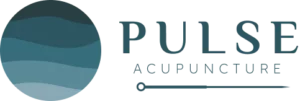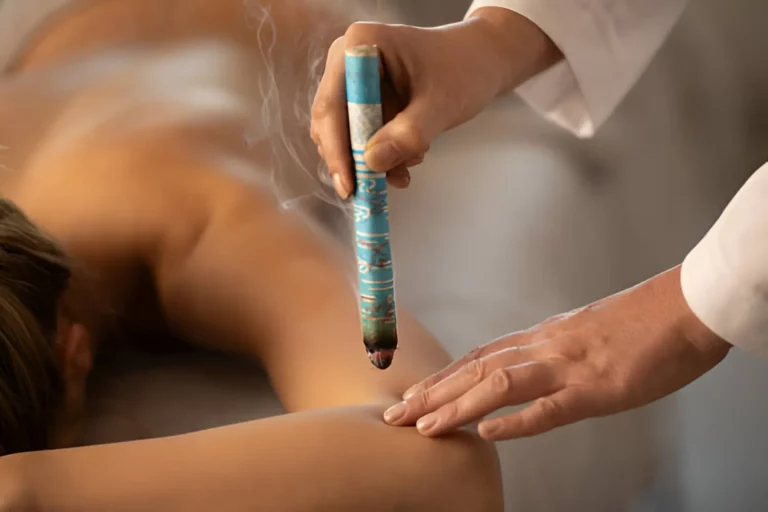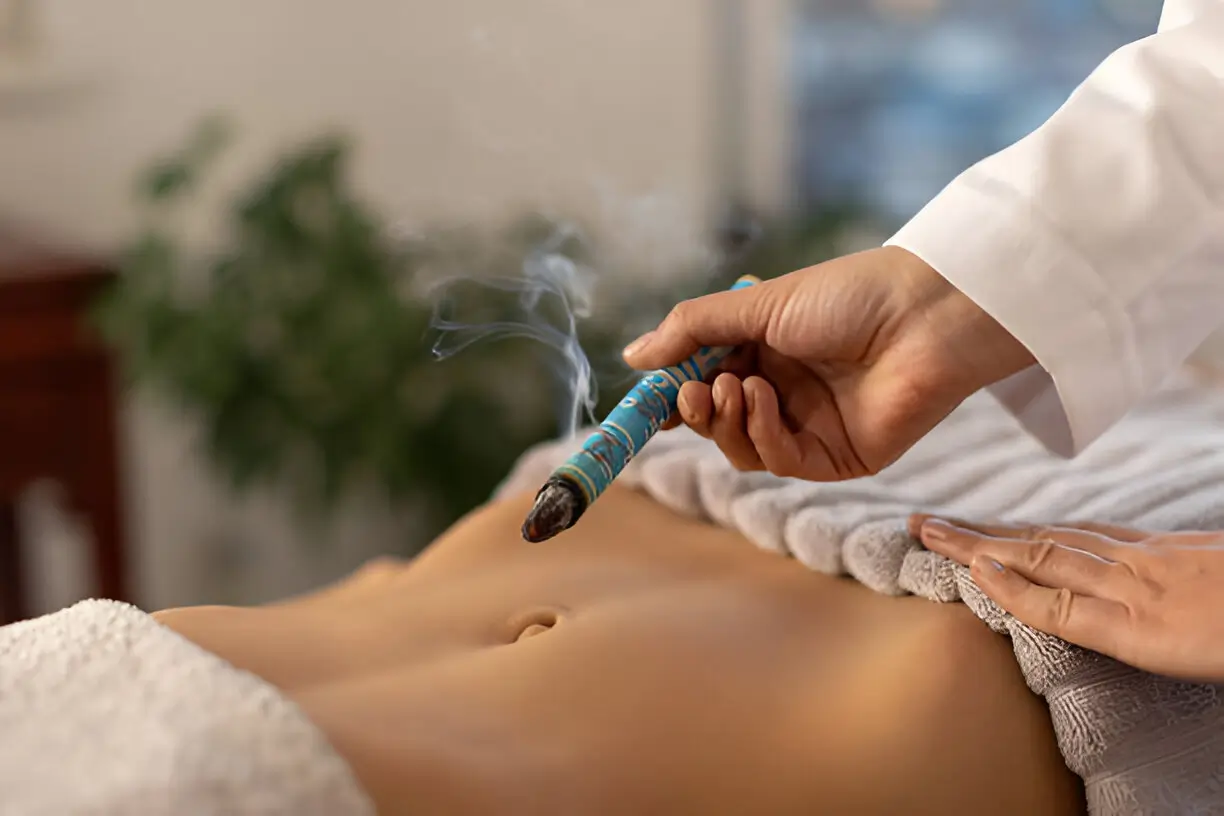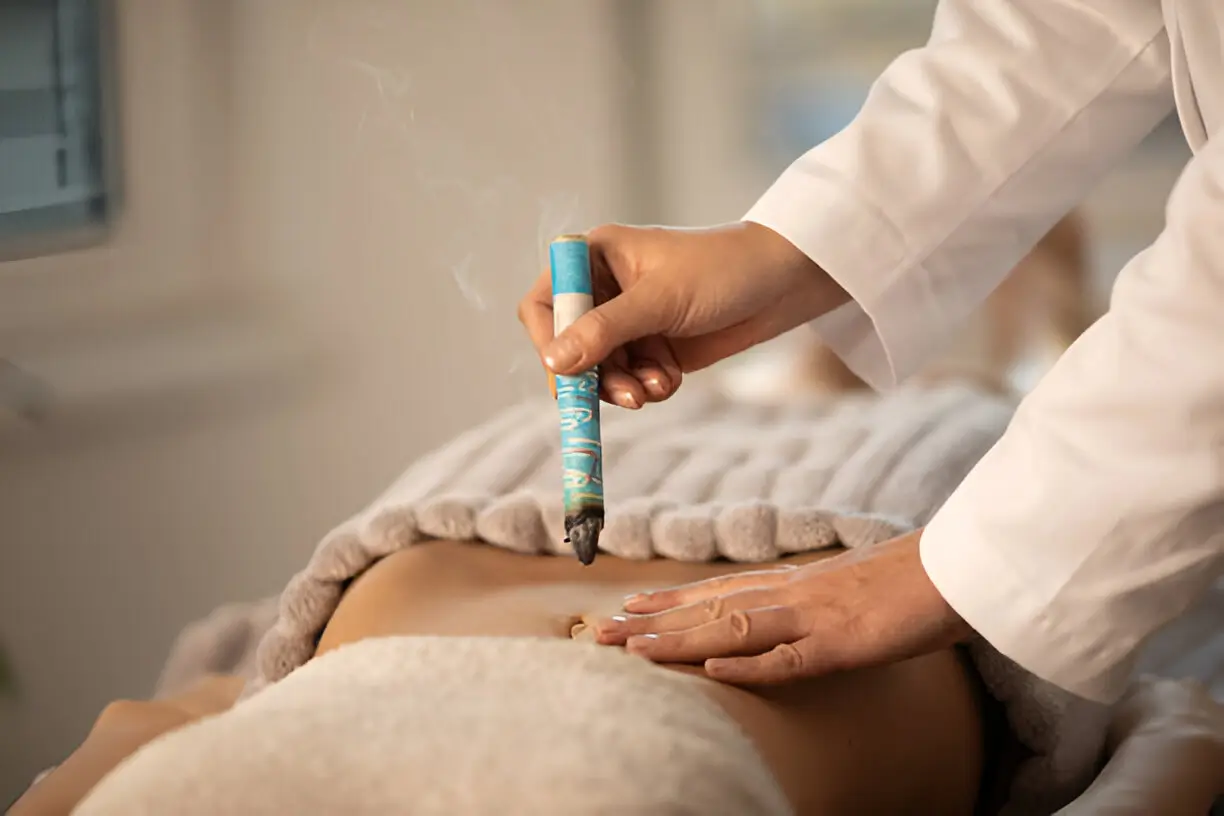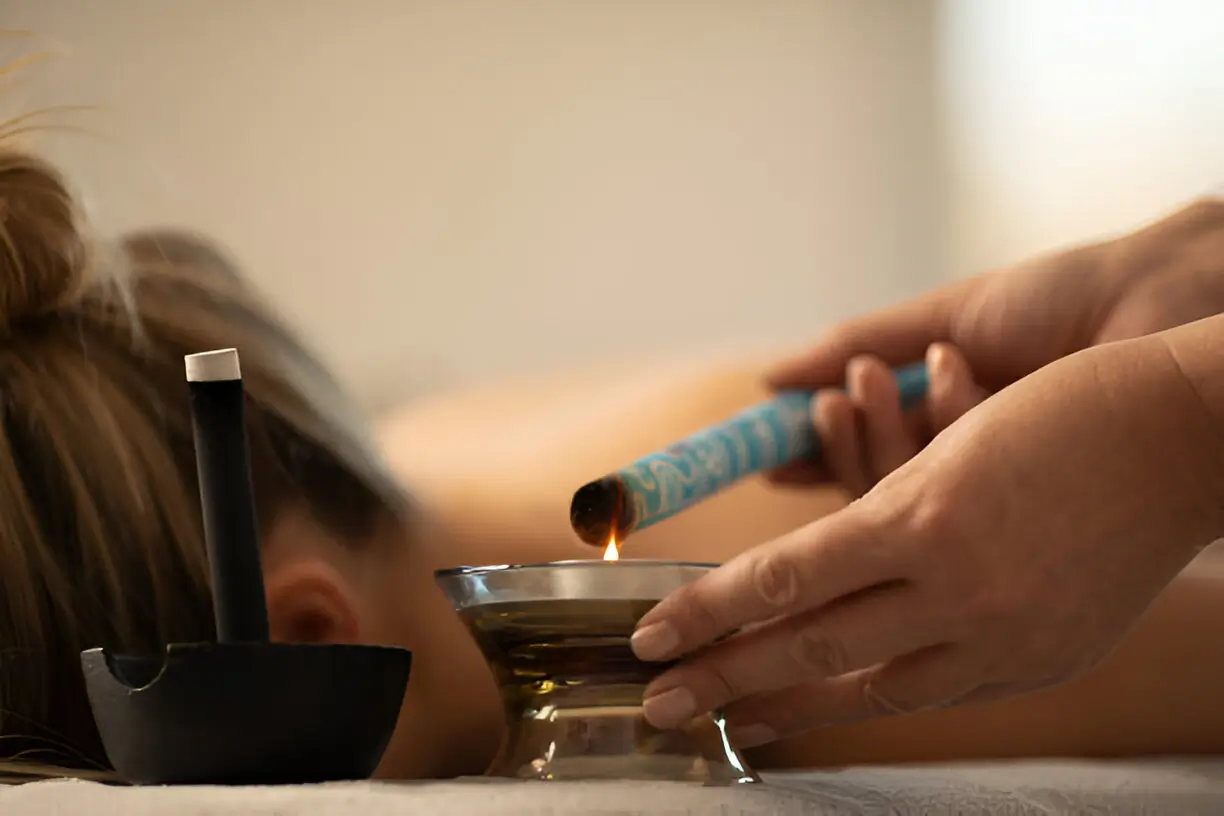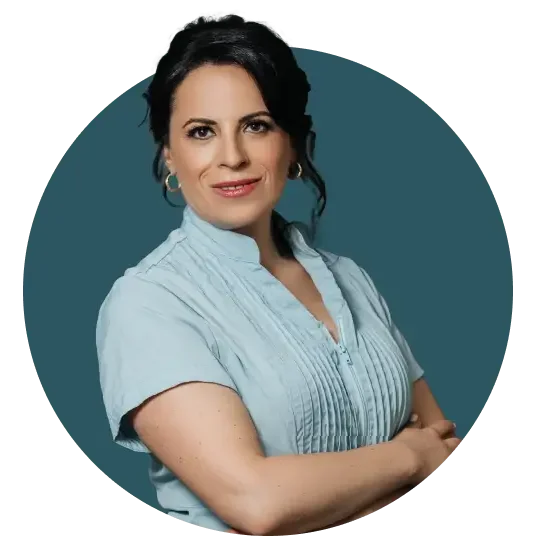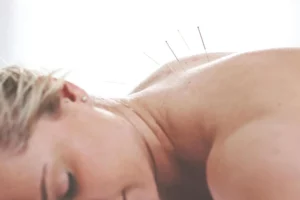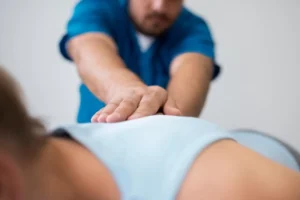What Is Moxibustion?
The Moxibustion definition: it is a heat therapy technique that has been a core part of TCM for hundreds of years. It primarily uses moxa, a substance derived from the dried leaves of the mugwort plant. In moxibustion, moxa is burned close to the body to warm specific areas, usually acupuncture points.
Moxa is typically used in two forms: as a loose powder, which is shaped into cones, or as a solid, cigar-like stick that can be burned close to the skin. The idea behind moxibustion is that the heat generated by burning mugwort penetrates the skin, stimulating blood circulation. It’s especially popular in treating conditions related to “cold” or “dampness” in TCM, such as arthritis, digestive problems, or menstrual pain.
How Is Moxibustion Done?
What is moxibustion in acupuncture? There are two main techniques for applying moxibustion: direct and indirect.
- Direct Moxibustion. Placing a small amount of moxa directly on the skin. The practitioner burns the moxa until the skin becomes warm. Direct moxibustion can be further classified into scarring and non-scarring types. In scarring moxibustion, the moxa is left to burn completely, often leading to a blister or scar after healing. In non-scarring moxibustion, the moxa is extinguished or removed before it burns the skin. Most modern practitioners use the non-scarring technique, as it is less painful and reduces the risk of skin damage.
- Indirect Moxibustion. This is a more common method where moxa is burned at a safe distance from the skin. The practitioner may hold a moxa stick over the acupuncture point, or place moxa on top of an acupuncture needle. The heat from the burning moxa is transmitted through the needle, warming the acupuncture point without burning the skin. Indirect moxibustion is considered a safer, more comfortable alternative for most people, especially for those who are new to the moxibustion therapy.
How Does Moxibustion Work?
In TCM, it is believed that moxa acupuncture works by stimulating the flow of qi and improving blood circulation in the body. When qi becomes blocked or stagnant, it can lead to various health problems, from joint pain to digestive disorders. The heat from burning moxa helps to unblock this stagnant energy, allowing qi to flow more freely.
Moxibustion is especially useful in treating conditions that are considered “cold” in TCM, such as arthritis or menstrual pain. The warming effect penetrates deep into the body, improving circulation and bringing warmth to areas that are deficient in heat. In Western medical terms, moxibustion likely works by increasing blood flow to targeted areas, which may help to reduce inflammation and promote healing.
Does Moxibustion Hurt?
One of the common concerns people have before trying moxibustion is whether it hurts. In most cases, moxibustion does not cause any pain. The sensation is usually described as a gentle, warming feeling, similar to the warmth from a heating pad. Just like a fire cupping. In indirect moxibustion, where the moxa does not touch the skin, the heat is moderate and well-tolerated by most people.
However, direct moxibustion, especially the scarring type, can cause discomfort. When the moxa burns directly on the skin, it may cause a brief, intense heat that can lead to blisters or scars. For this reason, scarring moxibustion is less commonly used in modern practices, and most people prefer the non-scarring or indirect methods, which are much gentler.
History of Moxibustion
This herbal medicine has been used for centuries in China, Japan, Korea, and other parts of Asia. The earliest written record of moxibustion dates back to around 581 B.C., but the practice is believed to be even older. Historically, moxibustion was often used alongside acupuncture to treat various ailments, from arthritis to digestive problems.
The use of moxibustion spread from China to other parts of Asia, where it has been adapted to local cultures. For example, in Japan, moxibustion has been developed into a highly refined and specialized art, with practitioners often using it for self-care. Today, moxibustion remains a popular treatment in TCM clinics worldwide, and it is increasingly being incorporated into Western medical practices as a complementary therapy.
Types of Moxibustion
Moxibustion can be performed in several different ways:
- Direct Moxibustion. Practitioner places moxa directly on the skin and burns it until it produces a therapeutic effect. It can be scarring or non-scarring, depending on whether the moxa is allowed to burn the skin.
- Indirect Moxibustion. Moxa burns above the skin, the doctor usually does it by holding a moxa stick near the acupuncture points. The heat radiates down, warming the skin without making contact.
- Needle Top Moxibustion. In this method, moxa is placed on the end of an acupuncture needle. The heat from the moxa travels down the needle into the acupuncture point.
- Ginger or Salt Moxibustion. Slices of ginger or a layer of salt are placed on the skin, and the moxa is burned on top. These substances act as insulating layers and are believed to boost the healing properties of moxibustion.
- Stick Moxa. One of the easiest forms of moxibustion. A cigar-shaped stick of moxa is lit and held over the skin, allowing the heat to penetrate specific points.
What Is Mugwort?
Mugwort, also known as Artemisia vulgaris, is the plant used to make moxa. The dried leaves are ground into small pieces, which can be shaped into cones or sticks for burning. Mugwort has been used in traditional Chinese medicine for centuries because of its warming and healing properties.
In TCM, mugwort is believed to help with circulation and boost qi. Western studies have found that mugwort contains several active compounds that may have anti-inflammatory and pain-relieving properties, which could explain why moxibustion is effective in treating conditions like arthritis or muscle pain.
When Is Moxibustion Used?
Some of the most common conditions treated with moxibustion include:
- Joint pain
- Gastrointestinal problems
- Menstrual cramps
- Fatigue
- Anxiety
- Digestive disorders
- Infertility
Moxibustion is also used to treat breech presentation in pregnant women. Practitioners believe that the heat from burning moxa applied to certain acupuncture points can help turn the baby into the correct position for delivery. Research has supported the effectiveness of moxibustion for this purpose, with many women reporting that their baby turned after a few sessions of moxa treatment.
What Are the Benefits of Moxibustion?
Some of the moxibustion benefits include:
- Warming the Body. Moxibustion is particularly useful for conditions that are caused by cold, such as arthritis or menstrual pain. The heat from the moxa helps to warm the body and improve circulation, which can help with these symptoms.
- Improving Blood Flow. The heat generated by burning moxa increases blood flow to the targeted area. This can help to reduce inflammation, promote healing, and ease pain. Improved blood circulation also supports overall health by ensuring that oxygen and nutrients are delivered to tissues more efficiently.
- Stimulating Acupuncture Points. Moxibustion is often used alongside acupuncture to boost the effectiveness of the treatment. The heat from the moxa stimulates the acupuncture points. This combination is particularly useful for treating chronic conditions.
- Boosting Immunity. Some practitioners believe that moxibustion can strengthen the immune system by increasing the production of white blood cells and improving immune function. This can make the body more resilient to illnesses and infections.
Possible Risks of Moxibustion
While it has many benefits, it is not without risks. If not performed correctly, moxibustion side effects can cause burns, blisters, or scarring. Pregnant women should also be cautious, especially when using direct moxibustion, as the heat could harm the baby if applied incorrectly. People with allergies to mugwort or smoke may also experience reactions, such as coughing or skin irritation.
It’s important to work with a qualified and experienced practitioner to make sure that moxibustion is done safely. When applied by someone knowledgeable about moxibustion side effects, the risks are minimal, and the moxa therapy can be a valuable addition to a treatment plan.
Moxa Aftercare and Follow-Up
After a moxibustion session, you’ll need to take proper care to maximize the benefits of the treatment. Practitioners often advise patients to avoid doing something way too active for a few hours and to stay warm. This helps to prolong the warming effect of the therapy. It’s also important to keep the skin hydrated after treatment, as the heat from the moxa can sometimes cause dryness.
Many people find that regular moxibustion sessions are necessary if you want to see significant improvements. Your practitioner can recommend the appropriate frequency of treatments based on your specific health concerns.
Moxibustion: Final Thoughts
It has been used for centuries to treat a wide range of conditions, particularly those related to cold or stagnant energy. While more research is needed to fully understand how moxibustion works from a Western medical perspective, many people report significant improvements in their symptoms after receiving moxibustion treatments.
If you’re interested in trying moxibustion, it’s essential to consult with a qualified practitioner who has experience with the therapy. Moxibustion, acupuncture, cupping, Tui Na massage and so on should always be performed by someone trained in traditional Chinese medicine to ensure the best results.
If you’re looking for moxibustion in Brooklyn or Clifton, NJ, visit Pulse Acupuncture to get started! We have personalized treatments like acupuncture and moxibustion, helping you achieve the best possible results for your unique condition.
Read also:
- Can Acupuncture Help with Weight Loss?
- Traditional Chinese Medicine: What You Need To Know
- Can Acupuncture Help With Anxiety?
Frequently Asked Questions About Moxibustion
What is Moxibustion?
Moxibustion is a traditional Chinese medicine therapy that involves the burning of moxa (a cone or stick of ground mugwort) near or on specific points of the body, known as acupuncture points. The heat generated by the moxa stimulates the flow of Qi (energy) and promotes healing by warming the body and improving circulation.
How Does Moxibustion Work?
Moxibustion works by applying heat to acupuncture points or specific areas of the body to promote healing, enhance the flow of Qi, and remove blockages or stagnation. The warmth of the moxa is believed to strengthen the body’s immune system, improve blood circulation, and help balance energy within the body.
Is Moxibustion Safe?
When performed by a trained and qualified practitioner, moxibustion is generally considered safe. However, like any therapeutic practice, it can have risks, such as burns if the moxa is placed too close to the skin or left on too long. It is essential to work with a licensed acupuncturist or TCM practitioner to ensure the correct use of moxibustion. People with certain conditions, such as skin sensitivities or conditions involving the lungs, should avoid moxibustion or consult with their healthcare provider before undergoing treatment.
What Conditions Can Moxibustion Treat?
Moxibustion is used to treat a variety of conditions, such as:
– Pain management: Chronic pain from arthritis, sciatica, lower back pain, and muscle spasms.
– Digestive disorders: Bloating, constipation, indigestion, and irritable bowel syndrome (IBS).
– Fertility issues: Irregular periods, blocked fallopian tubes, and improving circulation to the reproductive organs.
– Women’s health: Menstrual cramps, pelvic pain, and conditions like endometriosis.
– Respiratory issues: Asthma, colds, and bronchitis.
– Stress and fatigue: It can help reduce stress, anxiety, and promote overall relaxation.
Can Moxibustion Be Combined With Other Therapies?
Yes, moxibustion is often used alongside other Traditional Chinese Medicine (TCM) practices, such as acupuncture, herbal therapy, and cupping, to enhance overall healing. It can also be combined with Western medical treatments, especially for conditions like fertility, chronic pain, and digestive disorders. Always inform your healthcare providers if you are undergoing moxibustion so they can coordinate your care.
-
Marina Doktorman, M.S., L.Ac., is an experienced acupuncturist who obtained her Masters of Acupuncture from the Tri-State College of Acupuncture in New York City in 2001. During her studies, she focused on Chinese Herbology, a branch of Traditional Chinese Medicine (TCM) that utilizes herbs to complement acupuncture treatments. Marina is licensed in both New York (NY) and New Jersey (NJ) and holds a Diplomate of Acupuncture from the National Certification Commission for Acupuncture and Oriental Medicine (NCCAOM), indicating her expertise in the field.
